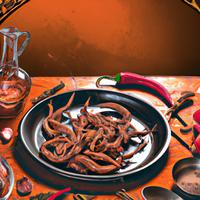
1 serving (150 grams) contains 250 calories, 20.0 grams of protein, 15.0 grams of fat, and 10.0 grams of carbohydrates.

Log this food in SnapCalorie

Nutrition Information
Calories |
394.3 | ||
|---|---|---|---|
% Daily Value* |
|||
| Total Fat | 23.7 g | 30% | |
| Saturated Fat | 4.7 g | 23% | |
| Polyunsaturated Fat | 0 g | ||
| Cholesterol | 110.4 mg | 36% | |
| Sodium | 788.6 mg | 34% | |
| Total Carbohydrates | 15.8 g | 5% | |
| Dietary Fiber | 0 g | 0% | |
| Sugars | 0 g | ||
| protein | 31.5 g | 63% | |
| Vitamin D | 0 mcg | 0% | |
| Calcium | 31.5 mg | 2% | |
| Iron | 3.2 mg | 17% | |
| Potassium | 473.2 mg | 10% | |
* Percent Daily Values are based on a 2,000 calorie diet. Your daily values may be higher or lower depending on your calorie needs.
Food Attributes
Source of Calories
About Fried snake
Fried snake is a delicacy enjoyed in various cultures, particularly in Southeast Asia, parts of Africa, and the southern United States. Typically prepared using snake meat, such as python, cobra, or rattlesnake, it is seasoned with spices, marinated, and deep-fried to achieve a crispy texture. Snake meat is high in protein, low in fat, and a source of essential amino acids, making it a nutrient-dense option for those seeking alternative proteins. Vitamins and minerals such as B vitamins, zinc, and magnesium are also present in the meat. However, fried snake may include added oils, fats, and sodium depending on the preparation, which could decrease its overall healthiness if consumed in large quantities. It's prized for its lean meat and distinctive flavor, which is often compared to chicken with a slightly gamey taste. Fried snake reflects traditional cuisines rooted in survival and resourcefulness.



